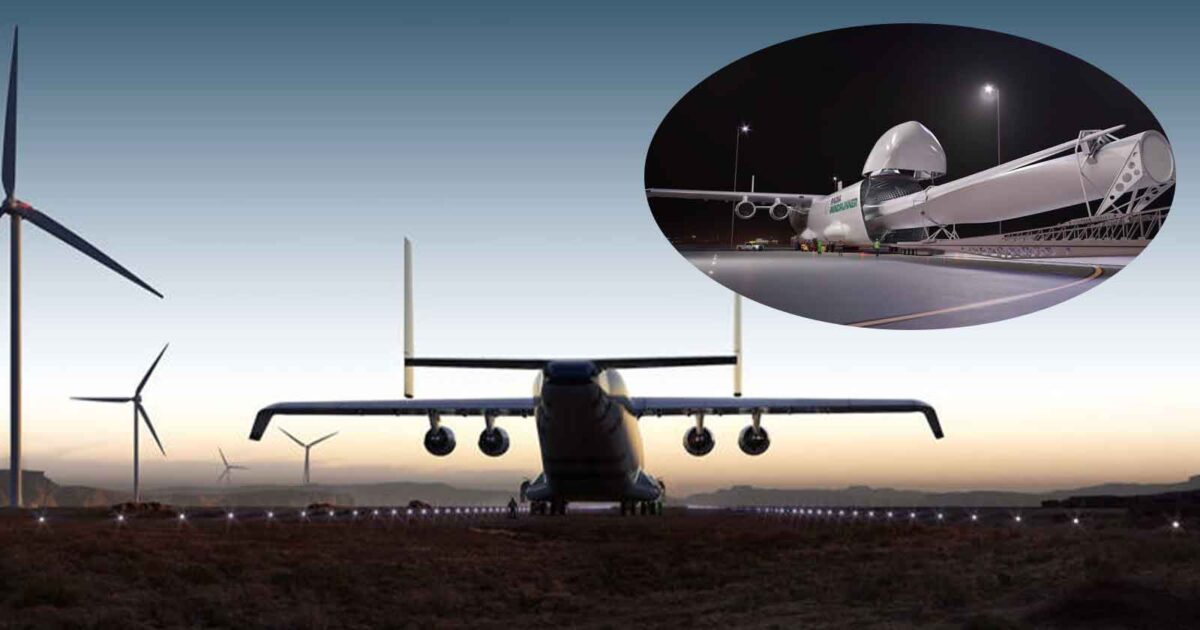
WindRunner: Mark Lundstrom, an aerospace engineer trained at MIT and a Rhodes scholar, has dedicated over seven years to designing the WindRunner—a colossal cargo plane poised to revolutionize renewable energy. If realized, it will stand as the longest aircraft in terms of both length and cargo capacity.
The primary objective of the WindRunner is to transport wind turbine blades, some as lengthy as football fields. These immense blades, currently utilized predominantly for offshore wind projects due to transportation constraints on land, hold the potential to unlock vast expanses for wind energy deployment. This innovation comes at a crucial time as the wind energy sector grapples with a stagnation in new onshore projects in the U.S. and volatility in offshore project costs.
Envisioned installations featuring these extended blades would tower approximately 300 feet higher than existing onshore turbines—equivalent to the height of the U.S. Capitol with the Washington Monument atop. Such projects promise to generate twice the energy of current onshore installations and expand feasible locations for wind farms.
Lundstrom’s company, Radia, headquartered in Boulder, Colorado, has maintained secrecy around the WindRunner’s design for years. However, they now reveal that the project is over halfway through its estimated eight-year timeline for design, construction, and certification.
Founded in 2016, Radia emerged from Lundstrom’s ambition to merge aerospace expertise with the energy transition. A pivotal moment came when he recognized the logistical challenges posed by transporting unwieldy wind turbine blades—an issue that resonated deeply within the industry.
The existing offshore-sized blades, due to their sheer size, pose transportation hurdles on land, necessitating specialized vessels for offshore deployment. Radia, boasting a valuation of $1 billion and backed by investments totaling $104 million, boasts a team comprising former Boeing executives, Federal Aviation Administration personnel, and experts from utility and renewable energy sectors. Noteworthy supporters include ConocoPhillips and venture firms like Caruso Ventures and Capital Factory.
Former U.S. Energy Secretary Ernest Moniz, serving on Radia’s advisory board, highlights the escalating demand for clean electricity driven by factors such as transportation electrification and increased energy consumption in manufacturing and data centers.
Lundstrom envisions Radia delivering wind turbine blades to project developers while also engaging in early-stage project development. However, the company does not intend to own or operate these sites.
The WindRunner, equipped with robust landing gear, is designed to touch down on 6,000-foot packed-dirt runways, necessitating construction at each project site. Lundstrom estimates that a project comprising around 25 of these super-sized turbines would be economically viable.
Radia’s inaugural customer is a prominent independent power producer undertaking a 1-gigawatt wind project in Nevada.
The adage “bigger is better” holds true in wind energy. Larger blades capture more wind, while taller towers position them in areas of consistent airflow, translating to enhanced electricity generation, even in regions with lower average wind speeds.
Radia anticipates that these larger turbines could slash energy costs by up to 35% and bolster power generation consistency by 20% compared to present-day onshore turbines.
Wind energy contributed approximately 10% to large-scale electricity generation in the U.S. in 2022, with states like Iowa, Illinois, Texas, Oklahoma, and Kansas leading the charge.
Jesse Jenkins, a professor at Princeton University who conducted a study for Radia, underscores the potential of larger blades and towers to render wind energy competitive across a broader swath of the U.S. However, the increased visibility of these structures may spark community resistance, posing a significant challenge.
Last year witnessed the slowest pace of new wind installations in a decade, attributed to factors like policy ambiguity and site selection barriers. Manufacturers also grappled with reliability issues in their largest products, primarily stemming from quality control lapses.
The WindRunner proposes to utilize existing technologies and components familiar to regulators, leveraging the established aerospace supply chain for construction. Rachel Kelley, Radia’s Vice President of Aircraft Development and former Boeing director of engineering, emphasizes the design philosophy of “innovating without reinventing the wheel.”
While constructing a new aircraft may seem extreme, Kelley contends that alternative methods of blade transportation are impractical. Blimps are restricted by weather conditions, helicopters prove costlier and riskier, and on-site mobile manufacturing demands temporary structures of staggering proportions.
The WindRunner boasts the capacity to transport one large offshore-sized blade at a time or up to four shorter blades, with potential applications extending beyond wind energy to include military and oil-and-gas industry equipment transport.



